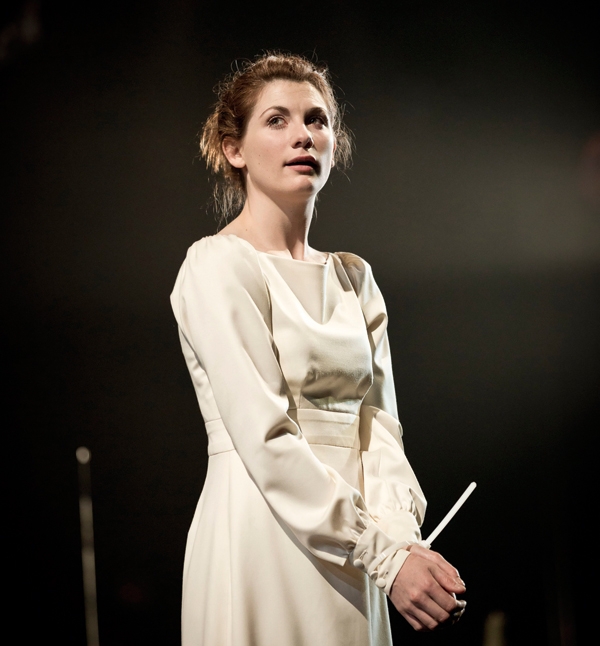When should you set Antigone? Apparently not in the time of Antigone. The greatest classics these days seem to be aimed at the stupidest ticket-holders. And these hapless wretches can’t possibly be expected to understand anything outside their immediate experience.
Polly Findlay’s version of Sophocles’ tragedy doesn’t even get modernity right. Her slightly out-of-date set design includes antique reel-to-reel tape machines and hefty old photocopiers the size of freezers. She’s taken Thebes and transplanted it to the studio of Crimewatch UK in about 1994. Very odd. The usual justification for these fast-forwardings is that they add relevance. They also close down curiosity and exempt directors from conducting the sort of research which, one imagines, they’d be eager to perform. But no, rather than finding out what ancient Thebans wore and how they conducted themselves, Findlay dumps the show in an open-plan glass office and lets the incongruities flourish.
Creon is surrounded by jackbooted heavies who call him ‘Lord Creon’ even though he’s dressed as a chief executive. He refers to himself as ‘the king’ despite looking every inch the president. And the punishment he hands down to Antigone, ‘wall her up in a cave’, appears to violate Article 77 of the Human Rights Act, namely ‘the right not to be walled up in a cave’.
The script manages to overcome the stale prejudices of the production. Christopher Eccleston, as Creon, has found a role that suits his strained and humourless temperament very well. And Jodie Whittaker has landed the part all women dream of. I’m not entirely sure why. There’s not much to Antigone beyond piety and defiance. But Whittaker pleads and aches with all the plangent soulfulness the part requires.
More time-travelling at the Donmar. Director Josie Rourke has sifted through the back-catalogue of absurdism and found The Physicists by Friedrich Dürrenmatt. This little-known Swiss surrealist was 41 when he wrote the script. Old enough to know better. We’re in a madhouse where the doctors are as barmy as the inmates. One nutter thinks he’s Einstein, another that he’s Newton. Some are feigning lunacy. Or perhaps all are. I forget the details.
Lots of nurses keep getting strangled to death and a smug police officer is investigating the murders with chortling incompetence. The play aims, rather casually, for one the most elusive registers in the theatrical repertoire: high farce. But the script veers inconsistently between slapstick and sententious propaganda. (The take-home message is that the discoveries of physics are so hazardous that its practitioners ought to be locked up.)
The script’s structure is unusually feeble. What is structure? It’s a promise made to the spectators that the writer has thought so carefully about the play’s development that they needn’t think about it at all. The viewer watches a well-structured play with a sense of quiet and knowing approval. ‘Ah, yes, how neat and gratifying, that’s exactly how I’d have arranged things myself.’
Abandoning coherent design, Dürrenmatt likes to leap gaily between naturalism and fantasy. And his acrobatics ought to be tremendous fun. They’re tremendously laborious. A horrible early scene turns us against the play’s atmosphere. A lunatic parades his madness to his wife and children by smearing himself in cream and capering around shrieking. Unfunny as it is, this episode becomes doubly nasty when we learn that the cowardly loon was simulating madness in order to abandon his family. Aside from these cruelties, there are long, long stretches of dialogue — lasting ten or even 20 minutes — which are as painfully tedious as cleaning someone else’s toenails.
Robert Jones’s set is a costly and effortful collection of irrelevances. Hanging over the stage are 20 huge metal electric lights. (What for? I haven’t a clue.) The back wall is covered with an expansive wooden flat intricately studded with closed doors. At the end, the doors are blown open to reveal a lengthening vista, in empurpled sunset, and a fall of petals. It’s a lovely effect but it doesn’t serve the drama. And what doesn’t serve the drama damages the drama.
The male actors lack charm, magnetism or good looks. The women are better. Miranda Raison is excellent as a randy nurse who falls in love with a nutty astronomer. And Sophie Thompson is terrific in a walk-on — or rather crouch-on — cameo as a hunchbacked shrink. The Donmar crowd tend to be grey of hair and short of patience and they’re perfectly capable of spending their fuel allowances elsewhere. (Quite a few bailed out at the interval.) More significantly, they’ve enjoyed an exceptionally rich theatrical diet over the past decade. They expect masterpieces revived with zest and originality, or neglected rarities presented with class and intelligence. This fringey muddle will baffle everyone.







Comments